Home » Hunting Dogs » Hunting Dogs Used to Target Florida’s Invasive Pythons
Hunting Dogs Used to Target Florida’s Invasive Pythons
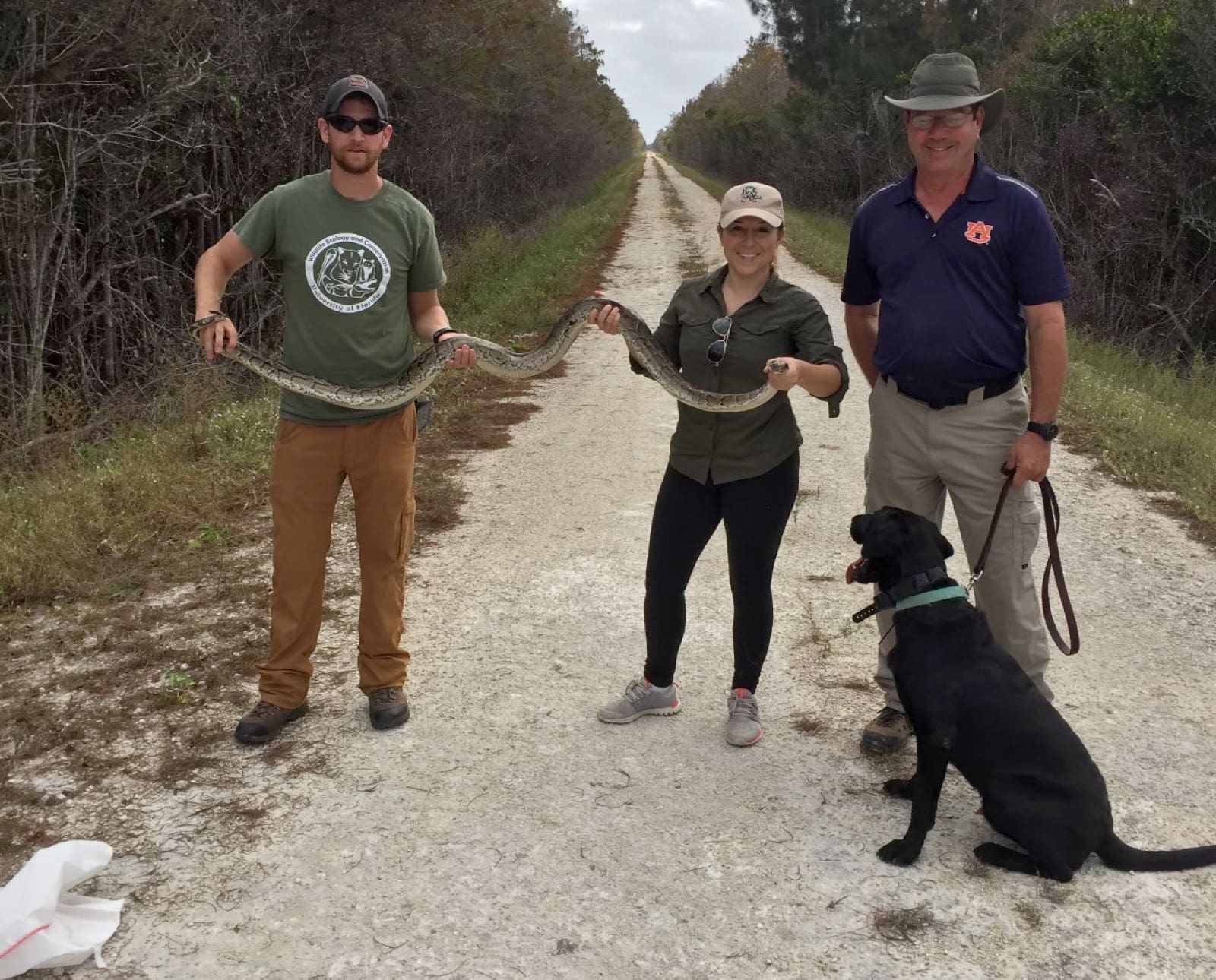
Bart Rogers grew up in the Appalachian foothills of Alabama,…
Labrador Retrievers are used to hunt invasive pythons through scent detection, protecting the threatened Everglades ecosystem.
The Florida Everglades represents a unique ecosystem not presently found anywhere else in the world. The subtropical wetland is the largest ecosystem in North America, a natural habitat for a diversity of species you won’t see anywhere else: countless aquatic birds; numerous endangered species such as the manatee, Florida panther, and American crocodile; and a slew of mammals that have been untouched other than by natural predators. It is the only place you’ll see an alligator and a crocodile in the same area. But at present, the Everglades faces many threats that could permanently change its landscape.
Listen to more articles on Apple | Google | Spotify | Audible
Invasive Pythons Come to the Florida Everglades
One of those threats is the importation of large constrictors and the subsequent release of pet pythons into the Everglades park. At first, every python that was found was determined to be a released snake from the pet trade, the first being documented in 1979. Because of their southeast Asian origins, the pythons were able to thrive in the south Florida climate and aquatic habitat of the Everglades. But because the habitat contained large predators like alligators, crocodiles, bears, and panthers, it was thought that they would be naturally controlled. If breeding occurred, it would be localized and assumed to not be able to reach a critical mass that would allow individuals to connect and proliferate.
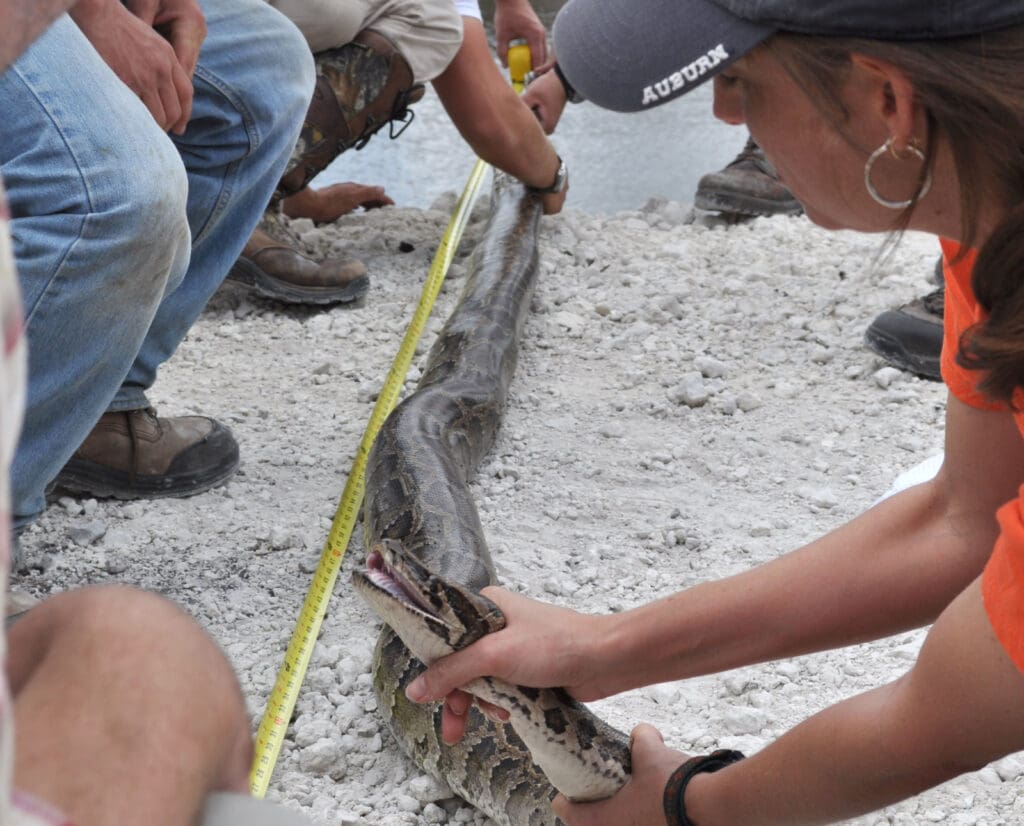
But by 2007, record numbers of pythons were being found and encounters were no longer sporadic incidents that could be attributed to releases alone. Hatchlings were found in areas where they had not previously been observed and in record numbers, confirming successful and non-localized breeding. Suddenly, experts realized that pythons in the park could readily seek out mating individuals during the breeding season. Not only were they capable of breeding, they now had a very successful population that was steadily increasing. In the winter of 2009, an extreme and prolonged cold snap not experienced since the 1940s gave some hope to attenuating the problem. Native species such as snook, tarpon, and manatees took a big hit. It was assumed that the ectothermic and primarily aquatic pythons would not be able to evade the extended cold snap like indigenous species that move underground to seek shelter, and even if they did, they would not be able to stay under for more than a couple of days before they had to resurface to thermoregulate.
But as winter faded into spring, park officials started encountering pythons and realized that the unusual cold weather had not made a significant impact on the population. Even worse was the realization that what had occurred was likely the first round of selection for cold-tolerant pythons in North America. Soon marsh rabbits, raccoons, foxes, and other native small mammals went from being extremely prevalent in the park to virtually nonexistent. But it was not only the small mammals falling prey to these novel predators. Because pythons do not have to move from an ambush point for reasons other than thermoregulating and breeding for upwards of a year, they are extremely efficient in converting prey to bodyweight and hydration—and if hungry and large enough, a python can take down and consume a 40-lb bobcat, 75-lb deer, and even large alligators.
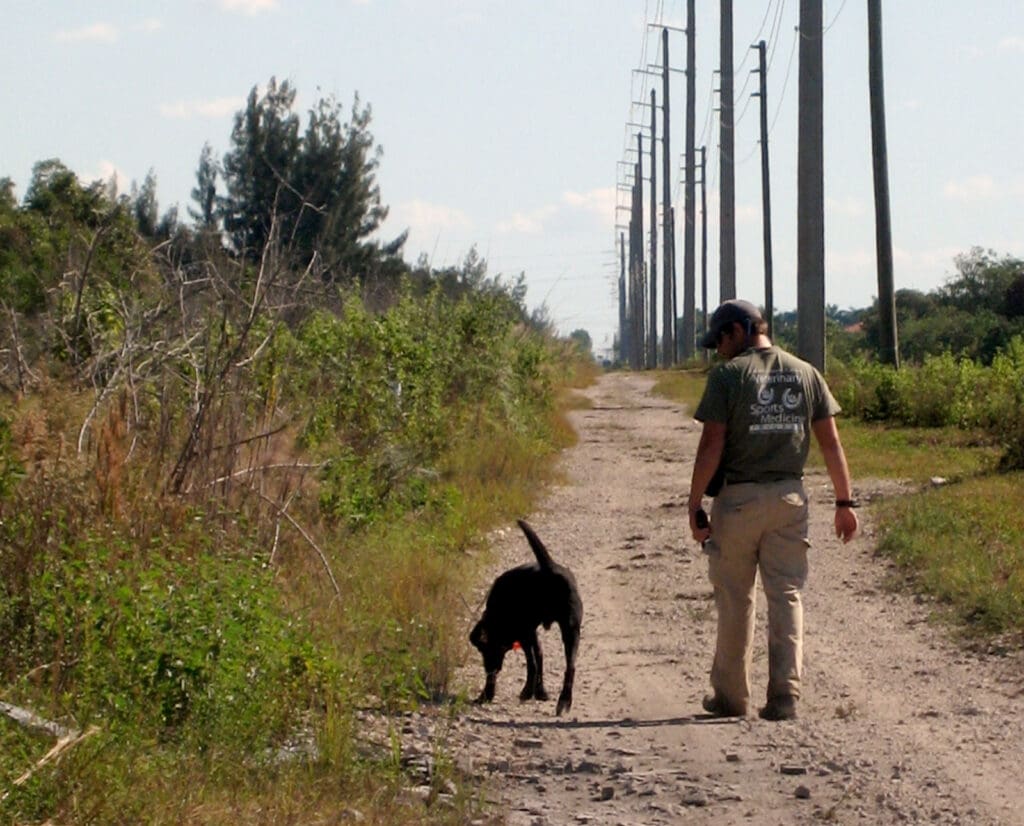
Using Dogs to Hunt Invasive Pythons
Concerns were at an all-time high over the repercussions of this new predator. Officials began seeking a variety of detection and eradication methods, with consultations ranging from engineers to exotic species traders. Attempts were complicated by the vast and diverse terrain, only 1% of which can be accessed by car or foot. Drones equipped with thermal imaging infrared cameras were brought in, but given that pythons are ectotherms, the effort was not successful. Early methods were not working, and the potential of the problem and its implications were growing.
Then came the dogs. A group of scientists at Auburn University including biologists, ecologists, and animal health experts had launched the EcoDogs program using detection dogs for conservation research that allowed a non-invasive method of species monitoring. Invasive species biologist Dr. Christina Romagosa worked with EcoDogs to organize a pilot project funded by the National Park Service to use these dogs for detecting pythons. At the time, I was involved in training the dogs to detect scat from eastern spotted skunk, striped skunk, and black bear. I heard that we were contacted about the python project and I was immediately interested in participating because I had substantial knowledge and personal interest in the Everglades and the issues it faced. I had trained detection dogs for various research projects, but had learned through the EcoDogs experience that using dogs to search in operational environments was very different than the static, in-house detection research I had previously conducted. I learned so much more about how to train a dog to search by working my dog through the woods—considering the climate, terrain, and how the elements interact with odor—that I had to make sure I was involved in this project.
To kick off the project, my supervisors went to survey the area to get an idea of what type of dog to select and how best to train them for this particular mission. They found that the majority of the area was inaccessible for the dogs because it was mostly covered in water. Dogs would not be able to work in the wetland areas because of the alligators, native venomous snake species, and jagged coral-limestone terrain. Instead, we had to devise a plan for how to safely and effectively work the dogs. Our challenge was to determine how the dog would need to search and how to train the dog for that type of search, given the environment and the behavior of the target. We would need the dogs to search canals, which meant linear searches. We would need to perform area reduction searches in vast agricultural areas with no visual cues, which meant quartering and systematically clearing transitional land on the edge of the park. We needed to train the dogs to search a lot of ground safely, quickly, and efficiently, detecting the cryptic target species without disturbance—in other words, we needed to train the dogs like bird dogs.
Fortunately, the majority of the task was going to involve roadway clearances, which our program at Auburn had an extensive background in due to training dogs for off-lead improvised explosives device (IED) detection. But the similarities stopped there. We would have to condition the dogs to work in the south Florida heat and humidity and the rugged terrain of the Everglades, and condition the dogs to detect a target that had never been done before. The unknown aspects meant that we weren’t sure which type of dog breed would be best suited for this unique task, so we selected three dogs with varying natural traits and hoped at least two would succeed.
First was Nancy, a two-year-old female black Labrador Retriever who had been part of the IED detection dog project. She was on her way toward deploying to the Middle East when she had a slight regression in training that caused her to return and ultimately miss her deployment. Nancy was fully trained to work off-lead and to respond to directional hand signals, which we thought may be useful for this project, and she was a steady-paced, calm dog that was eager to please.
Next was Ivy, a year-and-a-half-old female black Lab full of energy and enthusiasm to work. Ivy loved to engage with her handler and reward (a ball), making her highly trainable. She was environmentally resilient, meaning that she was confident and bold in dynamic environments. More importantly, Ivy did not have much training other than the very basics in explosives detection. We had no idea whether previous task-specific training could potentially impede training for this unique mission, so we chose Ivy as a clean slate.
Last was Jake, a male black Lab just over one year old. He had very high prey drive and energy levels, exhibiting the intensity and stamina to get the job done no matter what. However, that same vigor is what made him difficult to train and control—Jake was going to do whatever Jake wanted to do. Jake was a gamble because we knew that we needed a dog that would be highly tractable, but also possess a high level of independence and persistence to endure long searches in austere environments.
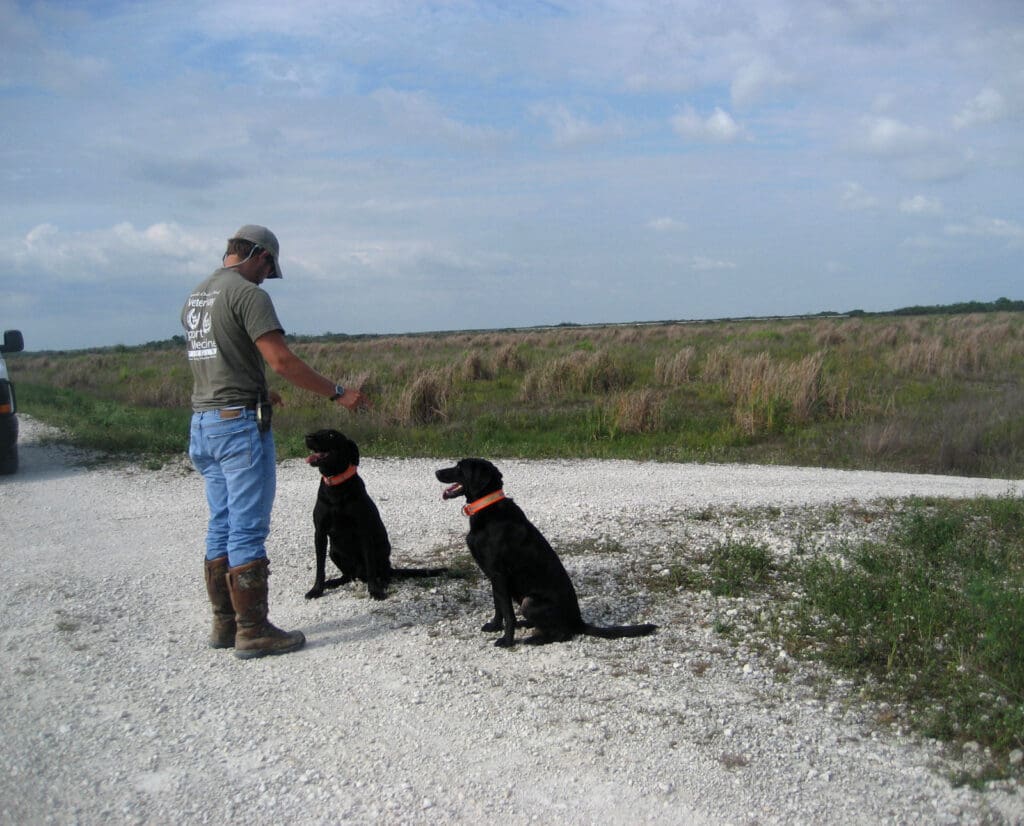
Training Dogs to Detect Pythons
An important piece of the preparation was physical conditioning. This involved building up the dogs’ physical stamina, which we accomplished by roading the dogs—wearing sled dog harnesses attached to all-terrain vehicles—until they were comfortably running around 8-10 miles at a time. We also had to condition the dogs’ feet to various surfaces to toughen up their foot pads, as well as acclimate them to working outside in various temperatures and environmental conditions.
To devise a dog training plan, we engaged biologists and other subject-matter experts to determine how we could condition the dogs to the odor without actually having pythons at Auburn. Samples were collected from pythons captured in the areas we would be working by swabbing individuals of varying sizes, sex, ages, and phases of shedding so that we could train the dogs on a natural spectrum of odor they may encounter, to avoid becoming too specific to the characteristics of the training samples. The key was for the dogs’ scent picture to be broad enough to recognize pythons in the wild that may differ from those that they saw in training, while also not responding to other native and highly prevalent species of snakes.
For training the necessary search technique, we started by using the explosive odors that the dogs already knew in order to teach them to perform the desired types of searches. We utilized Auburn University’s fisheries center to mimic our target environment, which would primarily be elevated levee roadways and man-made canal banks. We wanted to condition them to search downwind of thick vegetation lining canals and to sample downwind of large areas of marsh grassland. Importantly, we had to train the dogs to work ahead of the handler but not tread too close to the water’s edge. This transition area from the edge of the land to the water is an ambush zone for alligators and crocodiles but also the place where pythons are likely to be found.
As another layer of protection for the dog and to increase the likelihood of a capture once a python was detected, we decided to teach the dogs a “fringe response.” Similar to a bird dog pointing, which allows the hunter to get into position to flush the bird and take the shot, the fringe response is a passive response where the dog alerts at a distance from the target. When the dog encounters target odor in the air, the dog briefly brackets the scent cone. Once enough information from the brackets is obtained to determine the general location of the odor’s source, the dog gives an alert response by sitting with intense focus towards the source of odor. In typical explosives detection training, the fringe response is undesirable because we want the dog to identify the source of the odor. In our case, the fringe response would keep the dog at a safe distance from the python without alerting the python to our presence, allowing the handler to get into position to interpret the dog’s response, locate and identify the target, and communicate to the biologists where to retrieve the python.
A critical thread throughout all of the training was to prepare the dogs to be able to generalize, or bridge the gap, from the training odors and scenarios to wild pythons once we were in actual operations. To facilitate this, the next step was transitional training in a novel area where we could train with live pythons. We relocated to a USDA facility in Gainesville, Florida, where we had access to wild-caught pythons that we could hide (in bags) for the dogs to find. This was an effective way to give the dogs a more realistic experience with the target, vary the context, and strengthen the odor picture.
Our next challenge was training Labrador Retrievers to track scent on the ground, which is not an innate tendency for this breed (especially dogs from our program selectively bred for high levels of air-scenting). Once the dogs were confident with locating the odor of the bagged python placed in fields of varying vegetation densities, we then utilized large enclosures where we released radio-tagged pythons to train the foundations of tracking a python. We started the dogs upwind of the release site to ensure that they could not air-scent, meaning that their initial encounter with the python scent would be on the ground. Through a number of trials of these upwind scenarios, to my surprise, the dogs became very capable of tracking. Once we deemed the dogs proficient, we transitioned to the operational areas in south Florida. This last stage of training involved releasing radio-tagged pythons in former agricultural fields bordering the edge of the park proper. This gave the dogs experience with pythons moving in a larger, more operationally-relevant area, creating a scenario where the dogs would have to work odor in the air while encountering residual odor on the ground from the movement of the python.
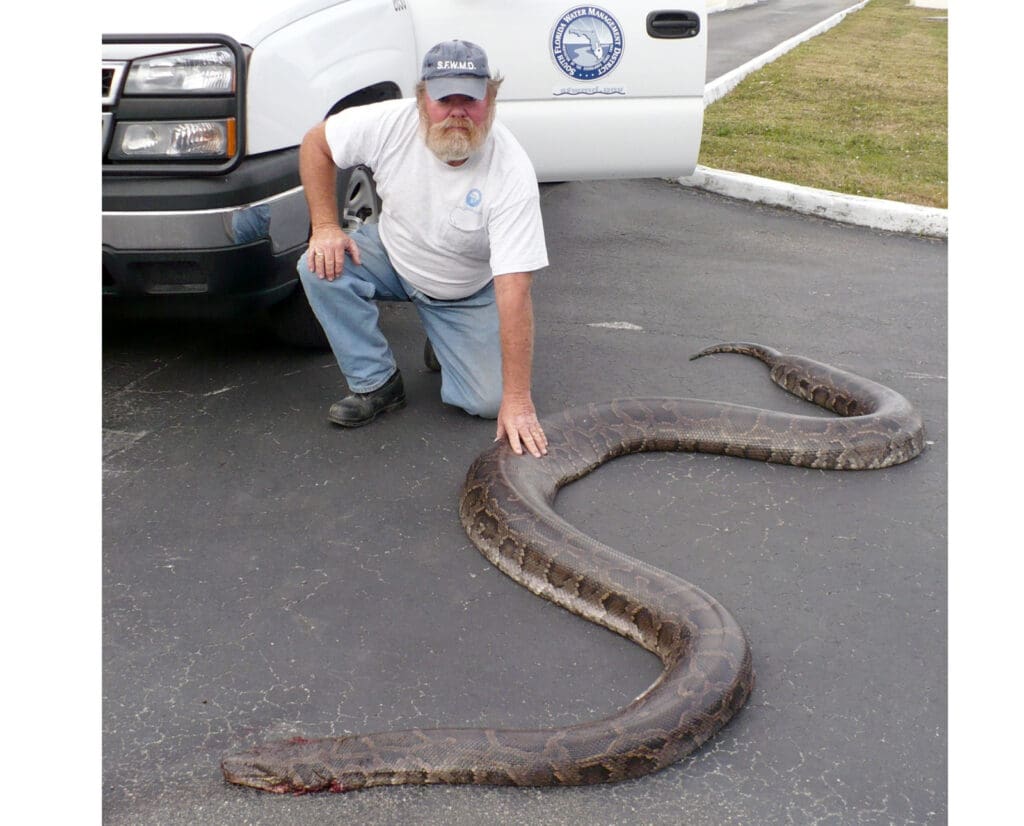
Hunting Invasive Pythons with Dogs
Near the end of October of 2010, we transitioned to operational areas in the Everglades that had high probabilities of yielding pythons based on historical finds. What we did not anticipate was that these areas would be rife with residual python odor of unknown age. And, in many cases, the dogs encountered odor and identified the source but we were unable to get to it for safety or accessibility reasons. Because of this, the task became a mental game for the dogs that proved to be more difficult for some than others. Nancy could not handle the frustration of the omnipresent odor that she could not obtain and had to be returned. We were quickly down to two dogs.
For Ivy, we could maintain her motivation but we had to utilize more maintenance training than desired to ease her frustration. But the more training we did with her, the more we ran the risk of getting further away from the wild python odor and making her too specific to the training odors.
Jake, originally our problem child, was not bothered by these factors that got to Nancy and Ivy. He would identify and communicate the source of the python odor; if we could not get to it, I would praise him and tell him to keep searching and he would eagerly continue without getting discouraged or frustrated.
We walked for about one month without finding a python. Then, the week before Thanksgiving of 2010, Jake showed the strongest recognition of odor that I had seen up to that point. Given the information that he conveyed by working the scent cone, I was quickly able to pinpoint the likely location of the python and sent in the biologists to recover an 8-foot male Burmese python. I rewarded Jake with his rubber ball and lots of celebration. This was huge—we had bridged the gap to a real find. Jake was super excited to go right back to work, and five minutes later, he found his second python. We went from one month with no success to two pythons within 30 minutes. I had to stop and evaluate how this happened so that I could put the dogs in the position to have the greatest success. We started trying to pattern the pythons based on data provided by the biologists to determine which factors dictated how they behaved. We utilized maps of the canals and levees and overlaid them with historical finds. Our weekly searches began to be dictated by wind direction and temperature. This is when I realized we were not just searching, we were hunting.
Now, things started to pick up and we were off to the races. This is when I really started to appreciate Jake and see him take his natural abilities to a level that we did not prepare him for in training. This is also when my role shifted. I was no longer the teacher—I was there to keep him safe and put him in position to be successful. He educated us in how the traits that we thought would be problematic actually resulted in something truly special. Ivy, who was also highly capable and productive in finding pythons but didn’t quite demonstrate extraordinary abilities like Jake, became a vital backup for when he needed to rest. At this point, all of the pressure of producing results and proving what we knew the dogs were capable of faded away.
In addition to learning to utilize the information from the biologists in the field to pattern the pythons through the lens of a hunt, the dogs taught me lessons that I will continue to appreciate and fall back on in different disciplines of detection training. One example came in the winter of early 2011, when Jake gave a strong indication and full alert response on an 8-foot-tall hedgerow atop a levee that led down to the canal below. I could not visually identify a python, so I figured that—given the wind direction and topography—the python was likely on the edge or in the water and the odor was being ramped up, pooling in the vegetation to where the dog could detect it. I crawled under the thick poisonwood and coco plum hedgerow vegetation (in hindsight, something the dog trainer should have left to the biologists) to see if there was a python on the edge and, if not, we would document that the python was likely submerged in the water and therefore could not be captured. As I was crawling to the toe of the levee, Jake did something I had never seen him do before. He started aggressively barking and growling and standing erect on his hind legs. I asked the biologist that was above me on the levee to leash and hold him, frustrated that he was behaving this way as he was trained not to be aggressive and to be obedient to odor. I climbed back to the middle of the vegetation and stood up so that the biologists could clearly hear me say that no python could be identified, when something moving in the corner of my eye grabbed my attention—a python easily over 10 feet long flicking its tongue within two inches of my face. I ran while yelling to the biologists that there was a python in the tree, an implausible scenario they couldn’t comprehend because pythons are an aquatic species not known to demonstrate arboreal behavior. Nevertheless, there was a 12-foot python in the tree. Jake knew it, and got frustrated that the humans were not listening to him no matter how hard he tried to tell me.
In the height of winter, over a period of several weeks, the dogs were finding a python every two hours (covering a distance of about six miles), in comparison to human roadway searches that yielded a python every 300-500 miles. Coming out of winter into early spring, when the ability to easily predict the pattern of the pythons based on breeding congregation and thermoregulation started to deteriorate, the dogs started to consistently show interest in one particular area. Jake began displaying air-scenting behavior, communicating that the python was across the canal. Given the frequency of this behavior in that one area, we reached out to the Miccosukee Tribe that owned the land and arranged for a reservation wildlife officer to transport us by boat to an elevated tree island across the water. As we were offloading on the bank and preparing to start the search, Jake detected odor on the ground. This was the first time that I had seen this strong of an indication to odor on the ground, since he had only foundational training experience with ground scenting. Not wanting to waste time or distract him while waiting on the team to finish getting ready, I grabbed the Miccosukee officer who was standing next to me and said, “Let’s go.” Jake was tracking, there was no doubt at this point, into thick vegetation and quarried limestone boulders piled up from the construction of the canal—not an ideal scenario for trying to keep up with a tracking dog. Roughly 100 feet into the track, he suddenly leaped straight up in the air as if he had been shocked and landed in a trained alert response, muscles shaking with excitement. Crawling on all fours with the officer behind me, trying to interpret what the hell I was witnessing, I gave Jake a strong command to stay while I crawled in front of him. In the leaf litter I saw the tip of a tail heading towards a steep embankment into the water. I planted my feet up against the quarried limestone rocks to give me leverage, grabbed what I could see, and pulled out more than 10 feet of python. This was a pivotal find for several reasons: Jake had detected the python across a body of water, it was the first time he was put in a tracking situation in real operations, and within three minutes of getting off the boat he found a 13-foot gravid female who became the first to hatch wild-bred pythons in captivity. By removing her, we removed upwards of 40 viable eggs from the Everglades.
Soon after, we finally received the permits to work in the park proper, which had been delayed because park officials wanted to confirm that the dogs were truly capable before taking the risk of putting them in areas visible to tourists. I met with the head biologist of the park, Dr. Skip Snow, to discuss where and how we could work in the park. He commented that he heard our dogs could not only detect pythons in an immediate area where we could locate and capture the python, but that they could also detect the residual presence of a python long after it had been there. From a biologist’s perspective, this skill could be even more valuable. To ultimately gain approval and access to the park, we were asked to search a one-mile stretch of road with no background information as to the reason for this particular search. Given that I was completely blind to the scenario, we started at a point that, based on wind direction that day, would maximize the dogs’ ability to detect anything in the environment. About a quarter of a mile from the end point, Jake indicated strongly to the presence of odor on the edge of the asphalt and grass line, worked straight to the middle of the road to the double yellow line, stopped, turned around, and worked into a thickly-wooded flooded area that was too submerged to continue searching safely. I brought Jake back to the area that he had strongly indicated in the road, allowed him to reconfirm, and tied flagging tape to a tree limb directly above where he had shown interest. I called Dr. Snow and told him that we had completed the search with no find but had one area of interest, which turned out to be where a tourist driving the road a week prior had encountered a python. This had been a test, and Jake passed with flying colors.
Expanding the Application of Python Detection Dogs
From the beginning of our operational searches, we were fortunate to work with South Florida Water Management District (SFWMD), which manages the water flow through man-made canals surrounding the park. They had sent us their invasive species management specialist, Bob Hill, who had grown up in south Florida and was the go-to guy for locating wildlife in the Everglades. He quickly took to the idea of the dogs detecting pythons, unlike so many others who had (rightfully so, given their backgrounds) been skeptical. Bob had been called many times to an SFWMD canal on the Atlantic coast where large pythons were consistently sighted by canal work crews, but were no longer there by the time he showed up. After observing the dogs’ capabilities, he asked us to come search the area once conditions were favorable. As soon as we had cooler temperatures and a good wind out of the east, we traveled to the new site. In the first mile, Jake showed a strong recognition of odor and a full alert response, leading to an 11-foot, 75-lb female python. This was an exciting search that proved that rapid response was likely the best utilization of the dog, demonstrating how effective the method could be in conjunction with other tools that allowed us to place the dogs in areas where humans struggled to locate pythons. After rewarding Jake and celebrating the success, I decided to let Ivy out to pick up where Jake left off to finish out the search. As we started to search with the dog vehicle following behind us, I heard all hell breaking loose from Jake’s crate on the truck. I stopped to check on him, since that behavior was unusual, and found that he was in the process of dismantling his crate in an effort to get out. Based on our past humbling experience with the python in the tree, I figured he must know something that we didn’t, so I put Ivy up and let Jake out. He hit the ground at a dead sprint down the roadway and recognized odor so abruptly that he slid into a sit response. It turned out to be a 13-foot male python, the largest male captured at that point, that had been paired up with the female we caught earlier. The male was running from us while we captured her. Jake knew it the whole time—he knew there was more than one out there, and knew the track.
We started this project against the unknown and with a degree of skepticism in the versatility of these dogs, only to realize that this was the most efficient detection method ever used on this effort. The success of the project and the invaluable knowledge that I gained is owed to those working dogs showing me what they are truly capable of if given the opportunity, resources, and willingness to trust them. More than anything, this experience was yet another demonstration of why dogs are here today, a true example of the story of man and dog.
Bart Rogers grew up in the Appalachian foothills of Alabama, with working dogs ranging from Border Collies on the farm to hunting with Redbones, Treeing Walkers, and Brittanys. He has been working with dogs professionally for over 12 years, having trained dogs for various working roles including explosives detection, wildlife conservation, and service/therapy work. Bart currently oversees the selection, development, and training of candidate detection dogs for Auburn University’s Canine Performance Sciences breeding program. His personal and professional passions are in working dogs, wildlife, and conservation, and finding ways for them to intersect.




Excellent article, actually riveting, at least to me. I would welcome updates on your efforts down the road. Including any thoughts of opening up a python season to give the bobs a break!
I grew up with field bred Labs and Field Bred English Cockers in N.Fl and S. GA. We had several that would track and alarm at snakes consistently. The bark alarm was different enough that you knew exactly what they were into. I was also an amateur Herp guy as a kid. I took a little cross Bred Cocker/Beagle mix “Purdey” with me snake hunting all the time. I would capture 10X with her on an outing….
Not really a surprise here. I have taught my working Labs/Cockers to Shed hunt, Blood trail and Bird hunt. Once you show them what you want, it’s game on!
Excellent and informative article about the incredible sense and function of tracking dogs. Hopefully, in addition to all the people putting in time to try and stop the havoc wreaked by the invasive pythons on the wildlife ecosystem in Florida, more dog use can strengthen the cause of checking and removing this giant problem. Well done!